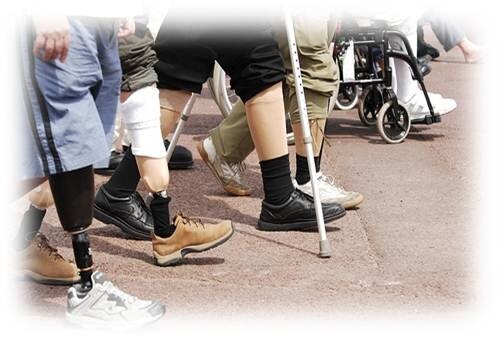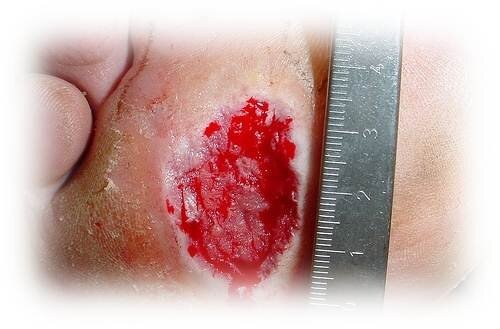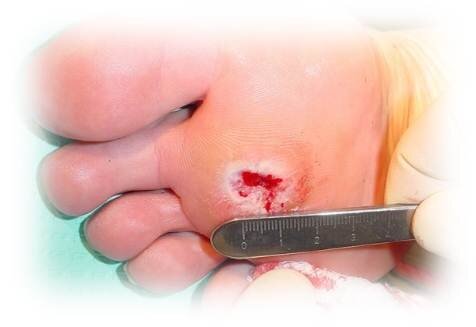Diabetic Ulcer Wounds And HBOT

The diabetic ulcer is one of the most common and devastating complications of diabetes mellitus. Diabetic ulcers account for most of the hospital admissions for patients with diabetes, and they represent a common precursor for amputation. When a diabetic foot ulcer becomes infected, gangrene and amputation can follow in rapid succession.
Diabetic foot wounds are consequences of the neuropathy and the small and large vessel disease that complicate diabetes. At the cellular level, the result is hypoxia which impairs wound healing. Hyperbaric oxygenation (HBOT) may be a useful adjuvant to wound care. It leads to enhanced oxygenation of the affected tissues, has an antiseptic effect, reduces edema, and accelerates collagen production and angiogenesis, thus enhancing tissue repair.
Review Of Scientific Trials Concerning Diabetic Ulcer Wounds
Reviews of scientific trials concerning diabetic foot lesions and amputations have stressed the magnitude and importance of aggressive management. This management is complicated, and typically requires radical debridement, appropriate antibiotics, non-weight-bearing, and vascular surgery when indicated. A variety of adjunctive therapy can be helpful, including hyperbaric oxygen therapy and topical growth factors.

Weisz, G. et al. "Treatment of the diabetic foot by hyperbaric oxygen." Harefuah 1993 Jun 1;124(11):678-81, 740. 14 diabetics with chronic nonhealing diabetic ulcer wounds which did not respond to treatment for at least 3 months were treated by HBOT. All had palpable pedal pulses. Transcutaneous measurements of tissue pO2showed elevation from 20 +/- 10 mm Hg during air breathing to 643 +/- 242 mm Hg while breathing pure oxygen at 2.5 ATA. They were treated with HBO in 56 +/- 10 consecutive HBOT sessions. In 11 there was complete wound healing, while in 1 there was partial response, in 1 minimal response, and in 1 a transient response. HBOT is useful in chronic nonhealing wounds of the diabetic ulcer foot and of the diabetic foot with impending amputation.
Lee, S. et al. "Hyperbaric oxygen in the treatment of diabetic foot infection." Chang Keng I Hsueh Tsa Chih 1997 Mar;20(1):17-22. BACKGROUND: This study evaluated multiple healing predictive factors in patients with diabetic ulcer infections to determine the usefulness of adjunctive hyperbaric oxygen in the treatment of such patients.
METHODS: From March 1995 to May 1996, we treated 31 diabetic patients presenting with infected foot lesions with a regimen of adequate metabolic control, frequent wound debridement and hyperbaric oxygen therapy. Age, gender, leukocyte count, total lymphocyte count, hemoglobin, erythrocyte sedimentation rate (ESR), c-reactive protein (CRP), glycosylated hemoglobin Alc (HbAlc), albumin, ankle-brachial index, types of bacterial cultures and number of debridements were compared between successful and failed treatments. Independent t-test and Fisher's exact test were used to identify the prognostic factors associated with outcome of treatment.
RESULTS: The mean age of the patients was 63.0 +/- 9.7 years (range 43 to 81). The mean number of hyperbaric oxygen therapies was 35.3 +/- 21.8 treatments (range 5 to 83). Of the 31 patients, 6 received below knee amputation, and 25 had their foot preserved or achieved a lower level of amputation. Elevated leukocyte count and low ankle-brachial index were significantly related to poor outcome. CONCLUSIONS: In the treatment of diabetic ulcer infection, adjunctive hyperbaric oxygen therapy seems to be a useful tool to enhance wound healing provided that there are preserved circulation and controlled infection.
Faglia, E. et al. "Adjunctive systemic hyperbaric oxygen therapy in treatment of severe prevalently ischemic diabetic ulcer. A randomized study. Diabetes Care 1996 Dec;19(12):1338-43 OBJECTIVE: To evaluate the effectiveness of systemic hyperbaric oxygen therapy (s HBOT) in addition to a comprehensive protocol in decreasing major amputation rate in diabetic patients hospitalized for severe diabetic ulcer foot.
RESEARCH DESIGN AND METHODS: From August 1993 to August 1995, 70 diabetic subjects were consecutively admitted into our diabetologic unit for diabetic ulcers. All the subjects underwent our diagnostictherapeutic protocol and were randomized to undergo s-HBOT. Two subjects, one in the arm of the treated group and one in the arm of nontreated group, did not complete the protocol and were therefore excluded from the analysis of the results. Finally, 35 subjects received s-HBOT and another 33 did not. RESULTS: Of the treated group (mean session = 38.8 +/- 8), three subjects (8.6%) underwent major amputation: two below the knee and one above the knee. In the nontreated group, 11 subjects (33.3%) underwent major amputation: 7 below the knee and 4 above the knee.
The difference is statistically significant (P = 0.016). The relative risk for the treated group was 0.26 (95% CI 0.08-0.84). The transcutaneous oxygen tension measured on the dorsum of the foot significantly increased in subjects treated with hyperbaric oxygen therapy: 14.0 +/- 11.8 mmHg in treated group, 5.0 +/- 5.4 mmHg in nontreated group (P = 0.0002). Multivariate analysis of major amputation on all the considered variables confirmed the protective role of s-HBOT (odds ratio 0.084, P = 0.033, 95% CI 0.008-0.821) and indicated as negative prognostic determinants low ankle-brachial index values (odds ratio 1.715, P = 0.013, 95% CI 1.121-2.626) and high Wagner grade (odds ratio 11.199, P = 0.022, 95% CI 1.406-89.146).
CONCLUSIONS: s-HBOT, in conjunction with an aggressive multidisciplinary therapeutic protocol, is effective in decreasing major amputations in diabetic patients with severe prevalently ischemic diabetic ulcer wounds.

Additional eight studies that evaluated HBO for treatment of diabetic foot wounds met the criteria for detailed review. All of these studies were prospective and controlled and four of the studies were randomized. The principal outcome measures in these studies were wound healing and rates of major amputation. These studies all found that HBO therapy combined with conventional therapy provided better outcomes than conventional therapy alone.
Benefits associated with HBO treatment included an increased rate of wound healing, increased incidence of complete wound healing, and decreased incidence of limb amputations in patients who received HBO therapy in addition to conventional wound care, compared with patients who received conventional care alone.
For example, in a small randomized controlled trial involving 30 diabetic patients with chronic foot wounds, Doctor et al. (1992) found that diabetic patients who received four 45-minute HBO treatments and conventional therapy had a statistically significant 3.6- fold decrease in the rate of major amputations compared with patients who received only conventional therapy. These investigators also found that after HBO therapy there was a statistically significant decrease in the number of bacterial species infecting wounds, although the clinical significance of this result is unclear since the density of bacterial infection was not reported.
Kessler et al. (2003) also conducted a small, randomized controlled trial of HBO for diabetic ulcer wounds and found that HBO provided benefits that were rather short-lived. However, the benefits of adjunctive HBOT for severe or gangrenous diabetic ulcer wounds seemed to be more significant in a larger randomized controlled trial.
Faglia et al. (1996) studied 68 patients and found that HBO therapy gave a statistically significant 1.4-fold decrease in foot amputation and 2.8-fold decrease in foot ischemia. The latter outcome was measured in air at normal atmospheric pressure after the completion of all HBO treatments, so it does not reflect the temporary hyperoxygenation that occurs during HBO therapy. However, the durability of this decrease in ischemia was not investigated after patients were discharged from the hospital. The decrease in ischemia may also be related to the leg artery bypass grafts and angioplasty provided to some patients.
Abidia et al. (2003) reported the results of a double-blind randomized controlled trial involving 18 patients with lower extremity diabetic ulcers. The patients who received 30 HBO treatments in 90-minute sessions had a statistically significant reduction in diabetic ulcer surface area at 6 weeks compared with patients who received hyperbaric air. At 1 year, no patients in the control group had complete healing, whereas 62% of the patients in the HBO group had complete healing. Other statistically significant improvements in patient outcomes were found in three prospective nonrandomized controlled studies of HBO therapy for diabetics with chronic, severe, and/or gangrenous diabetic ulcer wounds. These improvements included decreased infection, increased wound healing, and decreased major amputations.
In a quasi-randomized controlled trial involving 38 diabetics with chronic diabetic foot ulcers, 76% of patients in the HBO group had healed ulcers at 3 years versus 48% of the patients treated conventionally. A shortcoming of the studies of HBO therapy is that several came from the same group of investigators, and these investigators failed to provide sufficient detail regarding their criteria for decreasing the pressure from 2.5 ATA to 2.2 ATA and their criteria for ending HBO treatment.












